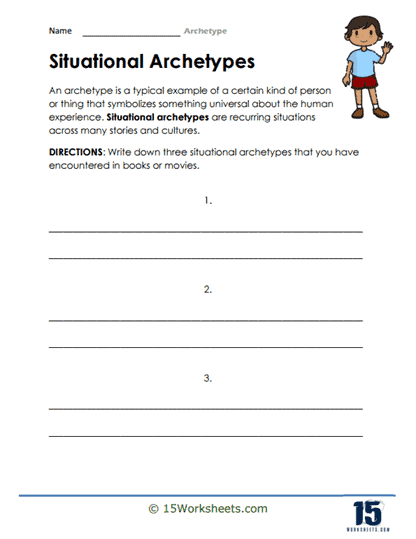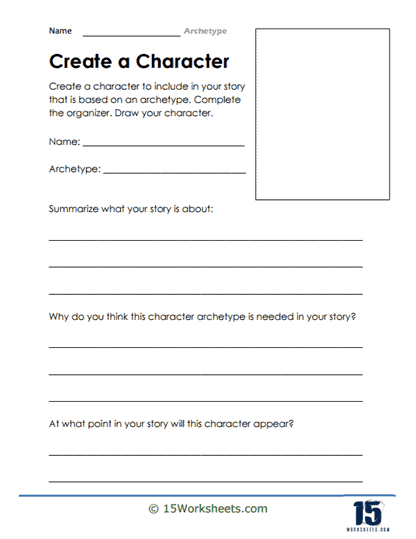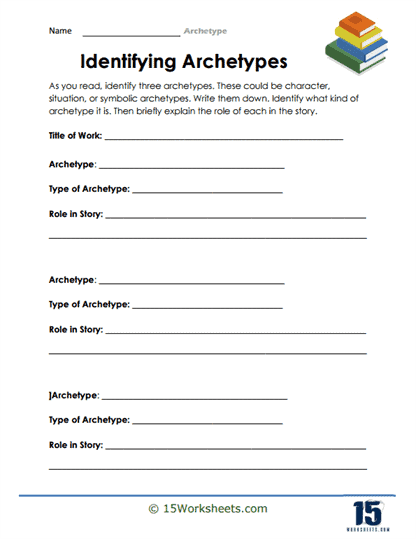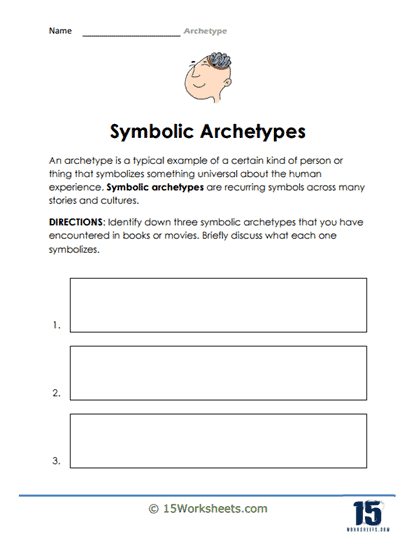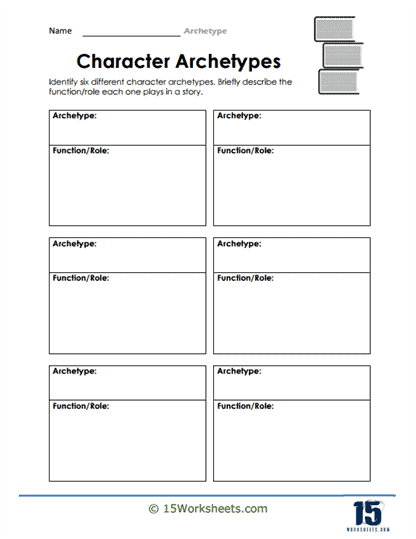Archetype Worksheets
All About These 15 Worksheets
Archetypes, universal symbols or themes that appear in myths, stories, and art across different cultures and time periods, hold the key to understanding the human experience. Recognizing and analyzing archetypes not only deepens a student’s appreciation for literature, storytelling, and culture but also enhances their ability to connect with and interpret the world around them.
In a world where empathy, cultural awareness, and critical thinking are essential, students must develop the ability to recognize, analyze, and apply archetypes in their reading, writing, and everyday lives. To empower students with the knowledge of archetypes and their profound applications, we proudly present a collection of 15 worksheets on Archetypes. These worksheets are meticulously designed to provide students with structured and engaging opportunities to explore, practice, and master the understanding of archetypes.
What Are Archetypes?
First, let’s talk about what an archetype is. The term “archetype” was popularized by a famous psychologist named Carl Jung. It refers to universally recognized symbols, themes, or characters that are present across different cultures and times. These can include the “hero,” the “villain,” the “wise old man,” or the “trickster,” among many others. Think about your favorite stories and you’ll find these types of characters and themes.
These worksheets are specially designed sheets that help you explore different archetypes. They usually contain a mix of text, pictures, and questions that encourage you to think about and understand archetypes. You might be asked to identify the archetypes in a story you’ve read or watched, or you might be asked to create your own story using specific archetypes.
Imagine a worksheet with a picture of a brave knight on it. The text could tell a short story about the knight’s journey, where he faces challenges, meets a wise old woman, and fights a wicked dragon. You would then be asked to identify the archetypes in the story. The brave knight is the “hero,” the wise old woman is the “mentor,” and the wicked dragon is the “villain.”
Another part of the worksheet might ask you to imagine your own story. What if the knight wasn’t brave but was instead scared of everything? What if the dragon was not wicked but kind? Would the story be as exciting? Would the story change dramatically? These kinds of questions challenge you to think creatively while also helping you understand the role archetypes play in storytelling.
Archetype worksheets can also help you connect to broader themes. If a worksheet focuses on the “hero’s journey,” an archetype found in many stories, you’ll be encouraged to think about what makes a hero. Is it bravery? Is it selflessness? By understanding these universal themes, you’ll deepen your understanding of literature and culture.
These worksheets can enhance your understanding of psychology. Remember, the idea of archetypes came from Carl Jung, a psychologist. He believed that these symbols, characters, and themes were part of our collective unconscious – a term for the shared experiences of all humans throughout history. For instance, why do we all understand the concept of a “hero” even if we come from different cultures or backgrounds?
What Is The Effect Of Archetype On The Reader?
Archetypes play a significant role in influencing readers’ responses to a text. By providing familiar symbols, characters, or patterns, they help the reader make connections and understand the story better. Here’s a deeper look at how archetypes impact readers:
Creates Familiarity – Archetypes are universally recognized and understood. When readers encounter these, they instinctively recognize them, which makes them feel more comfortable and connected to the story. This familiarity aids in better comprehension and engagement with the text.
Drives Emotional Connection – Archetypes tap into our collective consciousness and evoke strong emotions. A character facing a universal struggle, such as the Hero archetype battling the Villain, can arouse feelings of suspense, fear, excitement, and hope, which further immerses the reader into the story.
Promotes Universal Understanding – Because archetypes are universally recognized, they transcend cultural, geographical, and language barriers. They allow diverse readers to relate to the story and its themes, regardless of their background.
Enhances Depth and Meaning – Archetypical characters or situations often symbolize deeper meanings or moral lessons. For instance, a journey might symbolize personal growth, or a wise old man may represent wisdom or guidance. These add layers of depth to a story, encouraging readers to think more deeply about the text.
Facilitates Anticipation and Satisfaction – Certain archetypes create a sense of expectation for particular events in a story. For example, if a reader identifies the archetype of the “Hero’s Journey,” they might anticipate the hero’s trials, the guidance of a mentor, and the eventual triumph. This anticipation, when fulfilled, gives a sense of satisfaction and closure.
Encourages Reader Participation – Recognizing and analyzing archetypes can be an interactive process, where the reader actively engages with the text to discern patterns, motifs, and symbols. This intellectual engagement can make reading a more rewarding and fulfilling experience.
The Importance of Understanding Archetypes For Students
Understanding archetypes and their various forms is of great importance for several reasons:
- Literary Appreciation: Archetypes are essential elements of storytelling, appearing in countless works of literature, film, and art. Recognizing archetypes enhances students’ appreciation of the themes and motifs in literary works.
- Cultural Connection: Archetypes often reflect cultural values, beliefs, and ideals. Proficiency in interpreting archetypes enables students to connect with the cultural context of stories from different backgrounds.
- Empathy and Understanding: Recognizing archetypes helps students understand universal human experiences and emotions, fostering empathy and cultural awareness.
- Critical Analysis: Analyzing archetypes promotes critical thinking as students explore the recurring patterns, symbols, and themes in literature and media.
This collection of Archetype worksheets is a valuable resource for educators and parents committed to nurturing literary appreciation, cultural awareness, and critical thinking skills in students. Proficiency in recognizing, analyzing, and applying archetypes equips individuals with the tools to explore the human experience, appreciate the diversity of cultures, and interpret stories with depth and nuance. This collection is an investment in their future success, ensuring they have the skills to connect with the world around them, analyze the stories that shape our lives, and appreciate the rich tapestry of human experiences through the exploration of archetypes.
Explore these Archetype worksheets today, and watch your students embark on a journey of understanding, empathy, and insight as they explore the universal symbols that connect us all.











